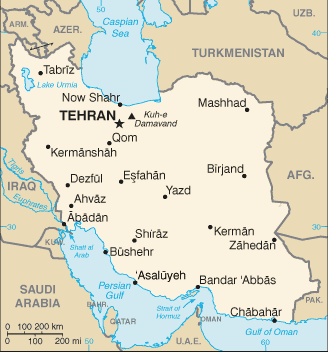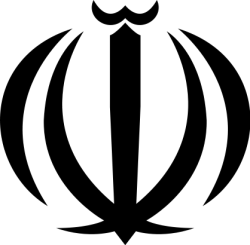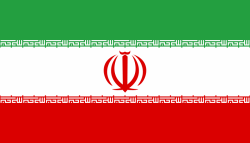Iran
Related Categories:

 Iran Coat of Arms
Iran Coat of Arms |
The colours of the Iranian flag are traditional, probably dating from at least the 18th century and they can be interpreted as representing the Islamic religion (green), peace (white), and courage (red).
www.fotw.us/flags/ir.html Iran - wikipedia.org
Iran as a land and a nation has one of the oldest histories in the world, extending nearly 6,000 years, and throughout history, Iran has been of geostrategic importance because of its central location in Eurasia.
en.wikipedia.org/
Iran is a pluralistic society. Persians are the largest predominant ethnic and cultural group in this country, though many are actually of mixed ancestry. The population of the country has important Turkic elements (e.g., Azeris) and Arabs predominate in the southwest. In addition, Iranian citizens include Kurds, Balochi, Bakhtyari, Lurs, and other smaller minorities, such as Armenians, Assyrians, Jews, and Brahuis (or Brohi).
The 1979 Islamic revolution and the 1980-88 war with Iraq transformed Iran's class structure politically, socially, and economically. During this period, Shia clerics took a more dominant position in politics and nearly all aspects of Iranian life, both urban and rural. After the fall of the Pahlavi regime in 1979, much of the urban upper class of prominent merchants, industrialists, and professionals, favored by the former monarch, the shah, lost standing and influence to the senior clergy and their supporters. Bazaar merchants, who were allied with the clergy against the Pahlavi shahs, also have gained political and economic power since the revolution. The urban working class has enjoyed somewhat enhanced status and economic mobility, spurred in part by opportunities provided by revolutionary organizations and the government bureaucracy. Though the number of clergy holding senior positions in the parliament and elsewhere in government has declined since the 1979 revolution, Iran has nevertheless witnessed the rise of a post-revolutionary elite among lay people who are strongly committed to the preservation of the Islamic Republic.
Most Iranians are Muslims; 89% belong to the Shi'a branch of Islam, the official state religion, and about 9% belong to the Sunni branch, which predominates in neighboring Muslim countries. Non-Muslim minorities include Zoroastrians, Jews, Baha'is, and Christians.
www.state.gov/r/
Introduction
About
Contact
Symbols in The News
Interpret this Symbol
AAC
African
AI
Alchemy
Alphabets
Ancient
Animal Symbolism
Architecture
Art
Articles
Astrology
Baha'i
Blissymbolics
Blueprint Symbols
Buddhist
Celtic Symbols
Cemetery
Chinese Symbols
Christian
Circle
City
Codes
Color
Conlangs
Crop Circles
Danger
Da Vinci Code
Designing Logos
Dictionaries
Dreams
Education
Egyptian Symbols
Electrical
Emoticons
Find Images
Fonts
Food
Fraternity
Hamsa
Healing
Heraldry
Hermetic
Highway Signs
Hindu
History
Hobo
Holiday
Icons
iConji
Islamic
Jain Symbols
Japanese, Kanji
Jewish
Justice
Law
Literary Symbolism
Mandalas
Map
Masonic
Math, Number
Meaning of Names
Medical
Middle East
Military
Miscellaneous
Money
Music
Mythology
Native American
Playing Cards
Power
Psychology
QiQiiKhu
Reiki
Religious
Runes, Norse
Sacred Geometry
Scientific
Science Fiction
Sorority
Sports
Symbols in the News
Tattoos
ThirteenSymbols
Tree of Life
Ursprache
Videos
Visual Languages
Weather
Web Codes
Wicca
Words
Writing Systems
Braille
Coinherence
Coptic
Cuneiform
Easter Island
Etruscan
Happy Human
Hebrew
Kokopelli
Linear B
Lotus
Love Symbols
Mandorla
Moon Alphabet
Nine Pointed Star
Om
Oz
Phonetic
Scarab Beetle
Silent
Theosophy
Unifon
About
Contact
Symbols in The News
Interpret this Symbol
AAC
African
AI
Alchemy
Alphabets
Ancient
Animal Symbolism
Architecture
Art
Articles
Astrology
Baha'i
Blissymbolics
Blueprint Symbols
Buddhist
Celtic Symbols
Cemetery
Chinese Symbols
Christian
Circle
City
Codes
Color
Conlangs
Crop Circles
Danger
Da Vinci Code
Designing Logos
Dictionaries
Dreams
Education
Egyptian Symbols
Electrical
Emoticons
Find Images
Fonts
Food
Fraternity
Hamsa
Healing
Heraldry
Hermetic
Highway Signs
Hindu
History
Hobo
Holiday
Icons
iConji
Islamic
Jain Symbols
Japanese, Kanji
Jewish
Justice
Law
Literary Symbolism
Mandalas
Map
Masonic
Math, Number
Meaning of Names
Medical
Middle East
Military
Miscellaneous
Money
Music
Mythology
Native American
Playing Cards
Power
Psychology
QiQiiKhu
Reiki
Religious
Runes, Norse
Sacred Geometry
Scientific
Science Fiction
Sorority
Sports
Symbols in the News
Tattoos
ThirteenSymbols
Tree of Life
Ursprache
Videos
Visual Languages
Weather
Web Codes
Wicca
Words
Writing Systems
Braille
Coinherence
Coptic
Cuneiform
Easter Island
Etruscan
Happy Human
Hebrew
Kokopelli
Linear B
Lotus
Love Symbols
Mandorla
Moon Alphabet
Nine Pointed Star
Om
Oz
Phonetic
Scarab Beetle
Silent
Theosophy
Unifon

